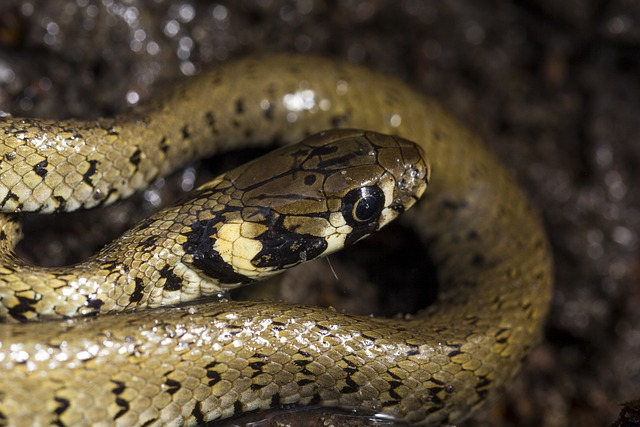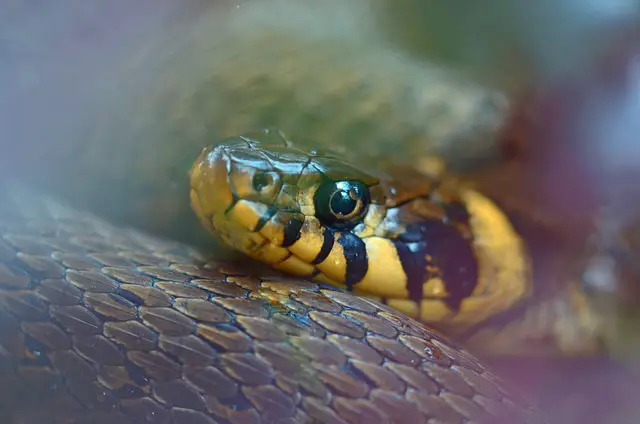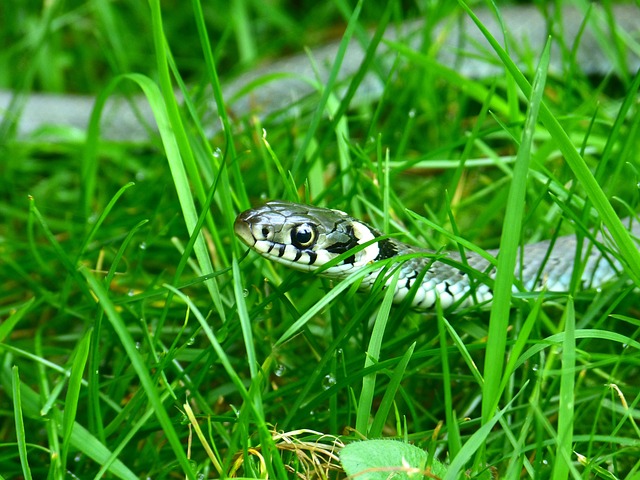Owing to their smaller size, ringneck snakes tend to eat smaller prey such as worms, slugs, and other insects. When keeping them as a pet, it is important to try to mimic their natural diet as much as possible.
Introduction
Ringneck snakes are a common type of pet snake and unlike some of the other domesticated species are relatively small. It is easy to imagine a pet snake as being huge, but since this species rarely grows much wider than a pencil, it is hardly surprising that their diet is vastly different from some of their bigger cousins.
Knowing what to feed you pet ringneck snake is essential in ensuring that he is well-taken care of and lives a long and happy life.
In this article, we are going to be looking at what animals these snakes prey on in the wild as well as giving you some important information on what to offer your snake in captivity.
What Do Ringneck Snakes Eat?
In the wild, larger snakes would usually prey on relatively large creatures such as mice, birds, and in some cases, larger species have even been known to feast on cattle and deer. But this ringneck snake is far smaller and would struggle with even a small mouse.
For this reason, their diet in the wild usually consists of insects and gastropods, including worms and slugs. However, they are also known to prey on their fellow reptiles and will often enjoy a meal of newt or salamander. There are some ringnecks who will also prey on smaller species or juvenile snakes if they are able to access them.
One of the key ways that ringnecks help to maintain a stable eco-system in their natural habitat is that they can effectively control the insect population. While they do eat certain insects themselves, by feeding on species such as frogs and small lizards who exclusively eat insects, the ringneck snake can control the population.
Furthermore, they are known to be great contributors to the fungi of the eco-system since eating worms and slugs helps to control the growth of this plant species.
As we mentioned, providing your snake with a diet that is as similar to what they would eat in the wild is essential, and whilst it may not be practical to source pounds and pounds of small lizards, pet owners are easily able to purchase insects and grubs for their slithery friends.
What Should I Feed My Ringneck Snake?
If you go to any pet store, you will notice that there is a vast array of foods for these types of reptiles. In the main, ringneck snake owners might purchase crickets or mealworms for their pets, and this would provide them with a very healthy diet.
But let’s take a look in a little more detail at the different foods you may be able to offer your ringneck snake.
Mealworms are an excellent source of protein for your ringneck snake, and they are widely available at almost every pet store in the world. You can also buy them from fishing tackle shops, but it is important to keep in mind that these will not have been specially bred for pet food so may not be of an equal quality to those you would find at your pet supply store.
One essential thing to keep in mind when offering mealworms as a staple part of the snakes diet is that alone, these will not be sufficient. If you do feed these to your pet snake, you must ensure that you are providing alternative sources of protein as well.
Crickets are another great food source for your ringneck snake, and they will likely go down a treat. You can purchase live crickets which are often preferred by many reptilian pets as this will allow them to pursue their prey as they do in the wild. You may find that you can train your snake into eating dead prey, but their natural instincts will always mean that they prefer it live.
Earthworms are another essential part of your snake’s diet and one of the staple foods when out in the wild. Once again, you can purchase live earthworms from pet supply stores or fishing bait suppliers.
The good news is that since these snakes are far too small to eat live prey that humans may find difficult to deal with, such as mice, you won’t be faced with a traumatic feeding experience.
If your snake does not have a varied diet, he will likely not thrive as well as he would in the wild. In the wild, there are some ringneck snakes that have been recorded to have lived for twenty years – this is quite surprising given their small size.
However, it is important to keep in mind that this is a record, and for the most part, you might expect a wild ringneck snake to live for around ten years on average. In captivity, the snake will likely not last this long and most pet ringneck snakes will pass away around the age of six.
In addition to food, you should also make sure that your snake has easy access to freshwater. The best way to do this is to place a shallow bowl on the bottom of the tank that is easy for your snake to reach.
Things To Avoid Feeding A Ringneck Snake
As with any animal, it is important to avoid feeding anything to your snake that could cause her harm. Of course, one of the main things to consider is the size of the foods you are offering. It is essential to avoid giving your snake anything too large as she may not be able to manage this.
As we mentioned earlier, some species of snake will happily chow down on larger foods like mice, but this would be near impossible for our smaller friends.
Furthermore, you should always be sure to purchase any food from a reputable supplier. Since ringneck snakes are known to eat insects and creatures that could be found in any back yard in the world, it can be tempting for owners to grab a tub and go hunting for snake food in the garden. However, whilst wild snakes may be able to stomach this, a domesticated animal may suffer harm.
The food that you obtain from a pet store or other supplier will have been bred especially for domestic pet use, in the wild, these creatures may carry bacteria that could be harmful to your snake.
If you do not like the idea of having to spend a small fortune on feeding you snake, there is some good news. You can breed your own crickets at home and whilst this may require ensuring the crickets are also well-fed, it can prove far less expensive in the long run and give you a continuous supply of food for your snake.
It is also important to remember that ringneck snakes are carnivores – they eat meat exclusively and therefore do not require any fruits, vegetables, or seeds and nuts in their diet.
Feeding A Wild Ringneck Snake
In places where the ringneck snake is commonly found – predominantly throughout North America, there is some temptation to adopt a pet from the wild. But this is never a good idea.
Taking a wild ringneck and trying to domesticate it will not do the snake any favors and his lifespan will likely be drastically reduced. While you may easily be able to source foods for him, the most humane thing to do would be to release him back into his natural habitat.
Conclusion
Ringneck snakes are one of the most common types of a small snake to keep as a pet, and it isn’t hard to see why; they are incredibly beautiful animals.
However, when keeping any creature as a pet, it is important that you keep their natural diet in mind and try to provide your pet with something similar to what they would eat in the wild.
In the wild, ringneck snakes would eat a variety of small insects such as worms and slug but would also feast on things like small lizards; newts, and salamanders as well as small frogs and juvenile snakes.
In captivity, you may feed your snake a diet that consists of crickets, mealworms, and earthworms, but you must always be sure to source these correctly to avoid causing harm to your pet.








